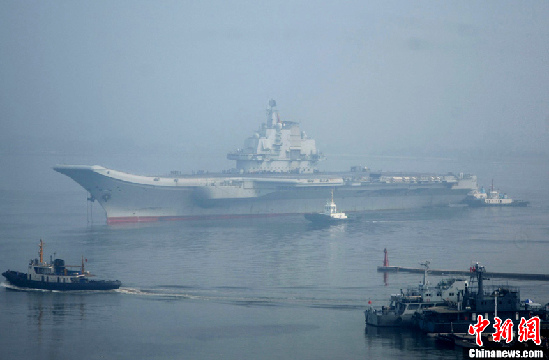
(Ecns.cn) -- China's first aircraft carrier has completed nine sea trials that started in August last year and some analysts say such a high frequency of tests is a sign that the country is set to formally introduce its aircraft carrier into service. Military officials have denied it however, notes Southern Weekly.
On July 30, the "Varyag" returned to the Port of Dalian in China's northeastern Liaoning Province after its longest sea trial which lasted 25 days. Three days later, Japan's Sankei Shimbun newspaper speculated that the aircraft carrier may begin service next month.
However, Colonel Lin Bai, with the General Armament Department of the PLA, told a press conference that the Varyag will continue to carry out tests and scientific research before it becomes a combat platform.
For several months, there has been much speculation saying that China's aircraft carrier is ready for service. So how does it actually take for a carrier to really enter service?
Jets on deck
Since its maiden voyage, tests on the aircraft carrier have been running very smoothly, attaining anticipated objectives.
In the first eight sea trials, the carrier, a refit of the former Ukraine vessel Varyag, has been tested in both the Yellow and Bohai seas.
The ninth sea trial was the most important, as it was the first time that domestic J-15 fighters had been involved in takeoff and landing exercises, moving China's aircraft carrier endeavors much closer to success, according to Southern Weekly.
Last month, some photographs taken by Dalian residents living near the port showed that several J-15s with their wings folded were parked on the carrier's deck. Then senior military aerospace analyst Douglas Barry ventured that the Varyag will probably be equipped mainly with J-15s in the future.
As the runway on the Varyag is only 200 to 300 meters long, a key preparation is to ascertain that aircraft can take off and land freely on the deck.
The J-15, also known as the Flying Shark, is China's first-generation aircraft carrier-borne fighter, which was developed based on Russia's Su-33 fighter. When the Soviet Navy was learning how to land a fighter on an aircraft carrier, it lost about 30 percent of its fighters in training exercises, said Southern Weekly.
China is starting from scratch, trying out landing and takeoff skills like a baby learning to walk, said military expert Luo Yuan.
Home-made arresting cables
After the Varyag returned from its first sea trial, Canada's Kanwa Defense Review asserted that China does not have the ability to make arresters by itself speculating that therefore the country's aircraft carrier endeavors will end in failure, cited Southern Weekly.
The arrester is an arresting cable that runs perpendicular across the deck, a very important device on aircraft carriers. The four large cables are usually controlled by hydraulics below deck. While landing, the aircraft's tail hook engages a cable and puts a strain on this cable, which hydraulics then dampen until the aircraft comes to a halt.
Fortunately, China has successfully designed its own arresters, and this assertion just melted away without being refuted, revealed Luo Yuan.
At first, China tried to buy arresting cables from Russia and Sweden, according to unconfirmed sources. But Luo denied that, saying China's own design best suits the country's own aircraft carrier.
Moreover, when the Varyag returned from its eighth sea trial, some people discovered that all the flame trap devices were erect, which implied that pilots may have mastered the takeoff skills on the carrier as well, noted Southern Weekly.
More time needed
The aircraft carrier still has many parts to be tested, including an important step called electromagnetic compatibility, said Song Zhongping, a military commentator, explaining that this will ensure that equipment or systems will not interfere with each other or prevent each other from operating correctly.
Besides, the aircraft deployed on the carrier are the soul of the fighting force of the Varyag, but the current version of J-15 has a weak point: its Russia-made Al-31 engines are less powerful than expected, according to Hu Siyuan, a professor with the National Defense University PLA China.
This will be solved when the jet is equipped with China-designed engines, said Hu, adding that the carrier's fighting force needs time to strengthen.
It is a military rule of thumb that it takes ten years to equip an army, 20 years for an air force but even more years for a navy. The build up of a navy is a systematic project, and as for the Varyag, it may need 10 years to become a fighting force, said Southern Weekly.

Copyright ©1999-2011 Chinanews.com. All rights reserved.
Reproduction in whole or in part without permission is prohibited.